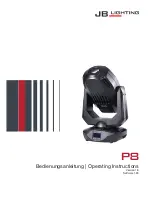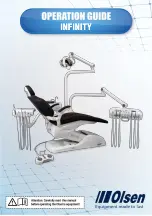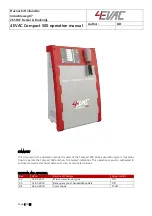
11
INM7700-6
Jan 2010
7.2
Power supply check
Check that the power supply to an individual barrier circuit (or to an
MTL7798 power feed module or an MTL7799 dummy barrier
sourcing the power bus ) is functional and that the voltage across the
supply with respect to earth is correct. For example, in Figure 20 the
presence of 24V on terminal 1 and 12V on terminal 2 when the
switch in the hazardous area is closed confirms the serviceability of
almost the complete circuit.
7.3
Barrier resistance test
To test the resistance of a barrier on site, refer to figure 20 and carry
out the following procedure:
a) Unplug hazardous-area cables from terminals 3 and 4.
b) Unplug safe-area cables from terminals 1 and 2.
WARNING: Take care when handling safe-area cables;
the relay contacts in figure 20 for example could be
carrying mains voltage.
c) Measure the end-to-end resistance of the barrier by connecting a
digital multimeter (set to a suitable
Ω
range) between terminals
1 and 3. The reading should typically be slightly less (eg 1–3%
lower) than the maximum end-to-end resistance listed in tables 4
to 10 for the appropriate barrier type or approximately 10–20%
higher than the figure specified in the safety description.
d) Check the functioning of the diode-return channel (,
7787P+, only) by selecting the diode test function on the
multimeter and connecting it between terminals 4 (+ve) and 2
(–ve). This measures the forward voltage drop of the Schottky
diodes in the chain: the reading should be less than 0.9V.
Repeat the test with the connections reversed (ie, terminals 4
(–ve) and 2 (+ve) for an expected reading of
∞
for the reverse
voltage drop.
e) Tests c) and d) confirm the continuity of both barrier channels. If
either channel is open-circuit it is most likely that the fuse has
blown. The safe-area circuit should be investigated in an attempt
to discover the cause of the fault.
Note:
if the barrier is removed, make sure the safe-area and
hazardous-area cables disconnected during operations
a)
and
b)
are connected to an earth-rail, a dummy barrier or insulated
completely.
c) If it is not possible to disconnect wiring to the barrier for steps a)
and b), carry out the tests given in table 4.
8
EQUIPMENT AND BARRIER TESTS
8.1
Thermocouple and RTD tests
8.1.1
Thermocouple circuit testing
Thermocouple test and calibration equipment is rarely certified
intrinsically safe and therefore requires special authorisation before it
can be used for testing or calibrating thermocouple circuits in
hazardous areas. To overcome this problem, the thermocouple
circuits can be protected by using an MTL7760ac barrier as shown
in figure 21. This permits the thermocouple output to be measured
without needing special authorisation to use uncertified thermocouple
test equipment.
As it is seldom possible to measure accurately the temperatures of
thermocouples located in hazardous areas, a safe way of adjusting
calibration tables to compensate for plant temperatures is needed.
This can be done by disconnecting the compensating cables from the
thermocouple, shorting them together, and measuring the temperature
of the shorting point.
8.1.2
Resistance temperature detector (RTD) circuit
testing
Resistance temperature detector (RTD) circuits can be tested by
disconnecting the measuring leads from the RTD head in the
hazardous area and connecting them to a resistance box. Sometimes
it is more convenient to connect the resistance box in the safe area,
for instance at point ‘xx’ in figure 22. For the latter method, however,
the RTD must be shorted out or an allowance made for its
temperature. The effect of a negative temperature change can be
simulated by connecting the resistance box into the measurement lead
at point ‘yy’. The advantage of connecting the resistance box at the
RTD head is that any leakage can also be determined by connecting
the resistance box at point ‘yy’.
8.2
Barrier tests
8.2.1
General
MTL7700 Series barriers do not need to be subjected to routine
testing if they are in normal use. Generally, the inspection tests
described in section 6 are more than adequate. However, if the
performance of barriers is in any way suspect, then carry out the
detailed tests described in this section. Barriers which pass these tests
satisfactorily are highly unlikely to represent an unacceptable level of
risk or cause a circuit malfunction.
There are two types of test (as shown by tables 4 to 10); a simple test
using a digital multimeter to test barriers on site and a more
comprehensive bench test using a constant current source to establish
the breakdown characteristics.
Although certification requirements concentrate on pulse-current tests,
in many ways the leakage current tests described in this section are
a more satisfactory method of testing suspect diodes. If a complete
functional check of a barrier is needed, then the multimeter and
constant current tests described in sections 8.2.2 and 8.2.3 should be
made although, for most purposes, the multimeter tests should suffice.
1
2
3
4
370
Ω
+24Vdc
12V
0V
400
Ω
12V
relay
Plant earth via DIN-rail
30mA
Figure 20
: Switch-status transfer circuit using an MTL7787 barrier
1
2
3
4
1
2
3
4
Compensating cables
Safe-area
equipment
Calibration
equipment
MTL7760ac
Figure 21
: Calibrating a thermocouple barrier circuit
www.calcert.com
1.888.610.7664
0
5
10
15
20
25
30










































